I have been to Costa Rica several times and spent time in all of the major regions of the country, although not all of the interesting places. A five-part video of early trips to Costa Rica is provided below.
At the bottom of this page there are links to a substantial number of individual bird species videos. The individual bird species videos are found in The Birds of Costa Rica video portfolio. The Birds of Costa Rica photo gallery contains well over one hundred bird photographs taken in Costa Rica. And lastly, the Costa Rica photo gallery consists of general interest photographs from the country.
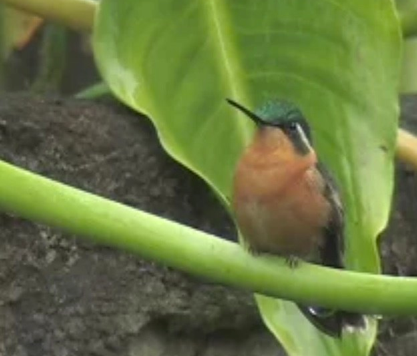
Osa Peninsula
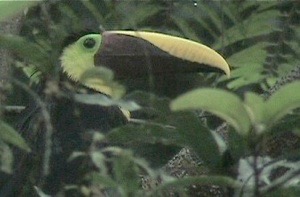
It is early evening in the middle of November. I’m tired, the rain pours straight down, the long suspended foot bridge sways with every step, the raging brown river is only a few feet below the narrow bits of tin roofing which are the foot-wide walkway of the bridge, it’s slick, lightening strobes the dark sky with brilliance, there is an occasional rope between the walkway and the cables at mid-shoulder -- there are no sides, I clutch one of the cables with my left hand, with my right I hold an umbrella keeping it low over my backpack -- trying to keep the camera equipment dry, I’m disoriented by all of the movement, I stop, then continue on...
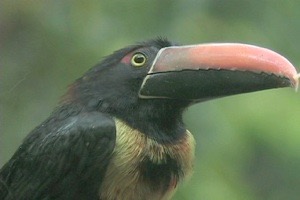
I’m on the Osa Peninsula in Costa Rica, it’s the end of the transition period between the wet and dry seasons and it is wet! Wet for a week, soggy sour smelling wet. It’s warm. It’s a blast.
Hiking in the mud, worrying about rain on the cameras, sweating, tired, my shirt is soaked with rain but it doesn’t wash out the sweat. Mist floating by, fording a small stream in a narrow canyon time and time again, just walk through the water, don’t hop across the rocks, the water is up over the rubber boots, so incredibly beautiful. Looking for owls. No owls. Later a Striped Cuckoo.
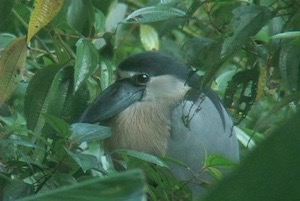
A month from now it will be dry and you can hike up the river, think of the vistas. Now the river is at flood but you can wade across 75 feet of swift muddy water, pick a wide straight channel because the water is lower, mid-thigh, shuffling feet along the gravel and rock bottom, don’t pick them up, if you do you’re gone, a foot cramp, that hurts. Across, sit down, empty the boots.
Lots of great images, even in the dark of the jungle, the camera is doing well. The Chestnut-mandibled Toucan (top), Fiery-billed Aracari (middle), and Boat-billed Heron (bottom) were all present - making for pleasant images.
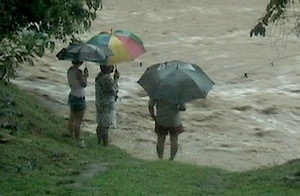
The staff had to ford the river to bring in food and other supplies. Over the course of a week I would see this drama play out daily. First, there would be the survey of the flooded river followed by the guy on the right heading into the water, returning the same way a few hours later with large sacks on his shoulders and water rushing by his chest.
As for me, tired, a hot shower, great food, wonderful people.
On March 27, 2008 I was working on an article about Costa Rica when I discovered that I really wanted some different pictures for Bosque del Rio Tigre in Costa Rica -- different than those posted in the Galleries. A frustrating morning led to the conclusion that I had not posted any photos from that location -- after much mulling I discovered four hours of tape which I have not even looked at, from the Osa Peninsula. Other than a bit of chagrin at having gotten side-tracked on that project I dealt with it in a straightforward manner and added the photo below to the article. Chagrin to sanguine over the course of an hour!

There are five volumes to the Costa Rica - A Birdwatching Adventure. Each of the volumes is embedded below or you can view them at The Birds of Central America, Mexico, and South America Video Portfolio. Videos of individual bird species recorded in Costa Rica can be seen at the links at the bottom of this page.
Volumes One and Two of this series include the following bird species; Groove-billed Ani, Slaty Antshrike, Collared Aracari, Rose-throated Becard, Red-winged Blackbird, Spotted-bellied Bobwhite, Northern Crested Caracara, Inca Dove, White-tipped Dove, White-winged Dove, Cattle Egret, Great Egret, Snowy Egret, Yellow-throated Euphonia, Laughing Falcon, Brown-crested Flycatcher, Sulphur-bellied Flycatcher, White-ringed Flycatcher, Great-tailed Grackle, Blue-black Grassquit, Common Ground-Dove, Gray Hawk, Roadside Hawk, Green Heron, Cinnamon Hummingbird, Northern Jacana, Tropical Kingbird, Green Kingfisher, Great Kiskadee, American Swallow-tailed Kite, Limpkin, Great Green Macaw, Scarlet Macaw, White-throated Magpie-Jay, Gray-breasted Martin, Eastern Meadowlark, Turquoise-browed Motmot, Streak-backed Oriole, Montezuma Oropendola, Orange-chinned Parakeet, Orange-fronted Parakeet, Red-lored Parrot, Yellow-naped Parrot, Ferruginous Pygmy-Owl, Spotted Rail, Solitary Sandpiper, Spotted Sandpiper, Thick-billed Seed-Finch, Stripe-headed Sparrow, Roseate Spoonbill, Black-necked Stilt, Wood Stork, Blue-gray Tanager, Palm Tanager, Double-striped Thick-Knee, Rufescent Tiger-Heron, Keel-billed Toucan, Elegant Trogon, Black Vulture, Turkey Vulture, Rufous-capped Warbler, Black-bellied Whistling-Duck, Willet, Hoffmann’s Woodpecker, Banded Wren, House Wren, and Rufous-naped Wren. It also includes recordings of the following mammals; White-nosed Coati, Mantled Howler-Monkey, Central American Spider-Monkey, and Variegated Squirrel.
Volumes Three and Four of this series include the following bird species; Red-throated Ant-Tanager, Collared Aracari, Bananaquit, Common Black-Hawk, Green-crowned Brilliant, Yellow-throated Brush-Finch, Sooty-capped Bush-Tanager, Gray-headed Chachalaca, Golden-browed Chlorophonia, Squirrel Cuckoo, White-tipped Dove, Yellow-crowned Euphonia, Boat-billed Flycatcher, Gray-capped Flycatcher, White-ringed Flycatcher, Tropical Gnatcatcher, Blue-black Grassquit, Yellow-faced Grassquit, Black-faced Grosbeak, Black Guan, Crested Guan, Little Hermit, Rufous-tailed Hummingbird, Stripe-tailed Hummingbird, Violet-headed Hummingbird, Brown Jay, Tropical Kingbird, Amazon Kingfisher, Great Kiskadee, White-collared Manakin, Green-breasted Mango, Broad-billed Motmot, Purple-throated Mountain-Gem, Mealy Parrot, Tropical Pewee, Black Phoebe, Band-tailed Pigeon, Short-billed Pigeon, Great Potoo, Clay-colored Robin, Violet Sabrewing, Black-headed Saltator, Buff-throated Saltator, Variable Seedeater, White-throated Spadebill, Orange-billed Sparrow, Blue-gray Tanager, Golden-hooded Tanager, Palm Tanager, Scarlet-rumped Tanager, Fasciated Tiger-Heron, Common Tody-Flycatcher, Chestnut-mandibled Toucan, Keel-billed Toucan, Emerald Toucanet, Orange-bellied Trogon, Violaceous Trogon, Long-tailed Tyrant, Green Violet-Ear, Buff-rumped Warbler, Three-striped Warbler, Buff-throated Woodcreeper, Olivaceous Woodcreeper, Streaked-headed Woodcreeper, Black-cheeked Woodpecker, Pale-billed Woodpecker, Gray-necked Wood-Rail, Banded-backed Wren, Bay Wren, and the House Wren. They also include video of following mammals; Central American Agouti, Honduran White Bat, White-nosed Coati, Collared Peccary, Hoffmann’s Two-toed Sloth, Central American Spider-Monkey, Red-tailed Squirrel, and Variegated Squirrel.
Volume Five of this series includes the following bird species; Riverside Wren, Golden-olive Woodpecker, Hoffmann’s Woodpecker, Wedge-billed Woodcreeper, Louisiana Waterthrush, Scarlet Macaw, Tennessee Warbler, Buff-throated Saltator, Blue-crowned Motmot, Orange-billed Sparrow, White-necked Puffbird, Variable Seedeater, Scarlet Tanager, Rufous Piha, Yellow-crowned Night-Heron, Chestnut-sided Warbler, Swainson’s Thrush, Black-headed Trogon, Violaceous Trogon, Ivory-billed Woodcreeper, Wilson’s Warbler, Black-throated Green Warbler, Torrent Tyrannulet, Spotted Barbtail, Ferruginous Pygmy-Owl, Spotted Rail, Solitary Sandpiper, Black-necked Stilt, and Black-bellied Whistling Duck. It also includes video of a river crossing and the following mammals; Red-backed Squirrel-Monkey and Greater White-lined Bat. It also includes video of a Brown Basilisk.
Costa Rica is a great nation to bird in, good infrastructure, friendly people, numerous ecosystems and lots and lots of bird species. I have videoed there many times. Here are some stories from those trips:
The First Story: Its mid-afternoon and pretty hot, we are at Hacienda Los Inocentes in the Guanacaste region of Costa Rica. The northwestern part of Costa Rica is dryer than the rest of the country and much of the countryside is dry forest.
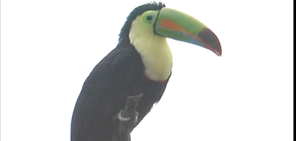
We have taped for nine hours today and its time for a siesta before we go out again in late afternoon. My son, Jon, and I are swinging in hammocks, talking about the day, talking about life. A Keel-billed Toucan flies in and begins to hop around in the rafters above us, fascinating stuff. It is hopping down a beam toward me, my son yells “It has a scorpion.” We are both out of the hammocks and several feet away before you can say “Costa Rica - A Birdwatching Adventure.” The Toucan drops the scorpion which lands on the cement beside my hammock. The Toucan flies down and picks up the scorpion and begins to beat it against the floor. After some time it throws its head back in the manner of Toucans getting food from the front of that magnificent beak to their throat, and swallows the scorpion. Great video. Toucan and scorpion just a few feet away, ruining a siesta but creating a great story.
The Second Story: The Resplendent Quetzal is a sought after bird. Rare and exotic, it is one of the world’s most beautiful birds. My first sighting of a Resplendent Quetzal was at Monteverde in Costa Rica - that is certainly the most famous place to see this species. I was walking in the Cloud Forest when a male flew into a tree on the other side of the ravine and perched in full sunlight with its long tail streaming in the wind. Following that my Resplendent Quetzal sighting were limited to the image on the national flag of Guatemala. That is, until I visited the Saverge Valley of Costa Rica -- Resplendent Quetzal heaven. There are many species of native Avocado growing in the valley, all fruiting at different times. As a result, the Resplendent Quetzal can be found there year-round -- often quite close (like the bird I photographed below). It feeds almost exclusively on Avocado, eating the fruit whole (the wild fruit is much smaller than the domestic type) and regurgitating the seed.
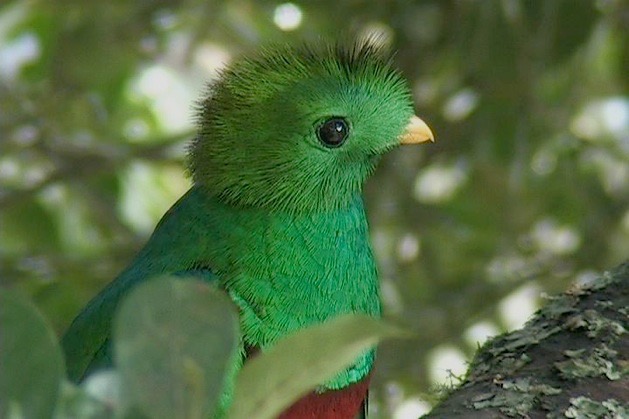
If you have a chance, see if Marino Chacon is available to guide you to the good spots, he is an excellent and friendly guide who has the patience of a saint.
The Third Story: The Brown Jay is a bird often sought after by North Americans, especially those who are interested in a North American ABA list (which does not include Mexico, even though it is in North America!). Birders of this ilk will journey to the south of Texas (USA), to the very banks of the Rio Grande River to see this bird -- and they will often hear it before they see it. That pretty well sums up my first experience with this species in the United States.
On the other hand, I have seen it many times in other countries, mostly in Costa Rica (like the bird I photographed below). Somehow though, this bird has never captured my imagination. It really is quite striking. It is large and can be easy to see. Its colors are pleasing, although subdued. But nope, not for me. Someday perhaps. I have been fascinated by European Starlings, House Finches, Dark-eyed Juncos -- you name it, why not the Brown Jay?

The Fourth Story: Moffett's "Adventures Among Ants", an account of his study of ants throughout the world, is an interesting read. Several of the chapters deal with species of ants which I have some familiarity with - in the sense that I have seen them and casually studied their activities.
For instance, I have enjoyed watching various species of leaf-cutter ants in my travels, marveled at their farming techniques and the construction of long and immaculate trails through the jungle - and always they make great video, carrying sections of leaf above their bodies as they move in mass along the trail. And the bullet ant of Costa Rica is a fearsome looking thing with a reputation which would cause anyone to take pause, a bite and sting that is incredibly painful and the pain lasts for days and days.
One of my favorite ant stories comes from Costa Rica, at Selva Verde where I was busy videoing a Tropical Gnatcatcher. My son was monitoring an army ant column nearby. As I focused on the gnatcatcher dusting itself I heard a shrike and the following explanation in short order: "I have been bitten by seven ant species on this trip!"
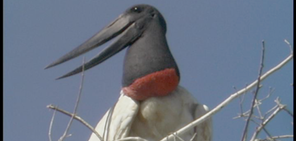
The Fifth Story: I am in Costa Rica and we were scoping a swampy area. Just as suddenly as the other birds had disappeared, a Jabiru appeared, lifting from behind a large bush a few feet away and, turning, it flew directly over me, its immense wings causing a local breeze. (The Jabiru to the right was photographed in the Pantanal of Brazil.)
The Sixth Story: My son and I were eating at an Ethiopian Restaurant that we enjoy, we sat outside languishing in the sun, watching the traffic and the people. The conversation drifted to coconuts and coconut milk. He was drinking a coconut drink (which tastes remarkably like coconut milk) and eating the chunks of coconut meat it contained.
He asked how cocoa nuts differed from coconuts. Putting aside the cocoanut variant spelling of coconut we ventured on to talk about cocoa trees. I reminded him that we had seen them in Costa Rica, the shell containing the seeds looking strangely like a coconut growing out of the trunk of a tree. He didn’t recall, then I mentioned that there was one near where we had taped Buff-rumped Warbler. He responded “by the stream?” My heart soared, that was exactly the spot, a spot he remembered several years later based on the species of bird we saw there. Perhaps (although not likely) he will be a birder someday.
RAIN
Typically if there is any chance of rain at all, I will carry a plastic garbage bag, or two, with me - just an insurance policy. If there is the likelihood of rain I will carry the bags and specially designed rain shields for the equipment. If it is raining I sometimes seek shelter in a dry environment and videotape “into” the rain. The photograph below of a Blue-gray Tanager taken at Rancho Naturalista in Costa Rica, is an example of this type of work. Rancho Naturalista, and many other places in the tropics, have covered areas which are great birding locations -- not typically for deep forest birds, but certainly for a good assortment of exotic creatures.
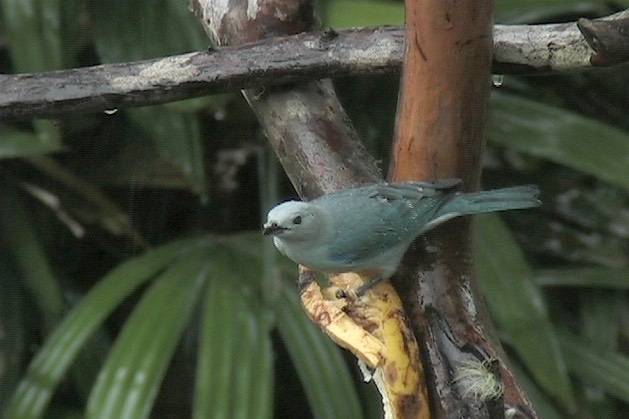
In my last visit to Costa Rica I was just passing time by taking video of Scarlet-rumped Tanager (I have quite a bit already), waiting for something different to come in out of the rain. The local guide referred to the bird as a Passerini’s - seems that I had missed a split. The Scarlet-rumped Tanager has been split into two species, the Passerini’s of the Caribbean slope and the Cherrie’s of the Pacific slope and Panama.
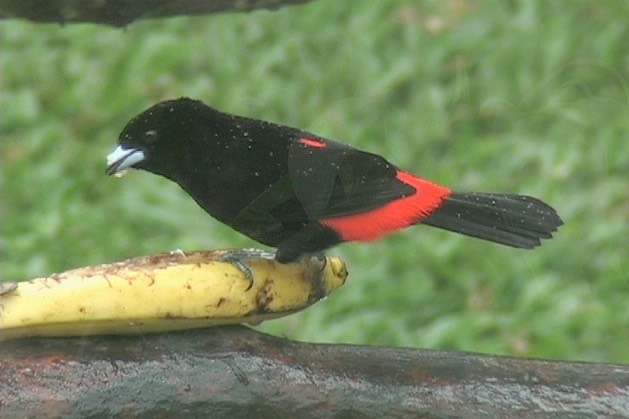
The male Passerini’s (pictured above at Rancho Naturalista) is indistinguishable from the male Cherrie’s (as far as I can tell) - the differences in plumage are found in the female. My impression, however, is that individual variation in the females of both species may be as significant as the variation between species - leaving range as the most reliable way to identify the two - a very unsatisfying situation. It is possible, of course, that as we become more familiar with the two species the differences will become more obvious.
This situation brings to light another complexity for the birding community - how to keep up with the splitting and lumping of species. This can be even more problematic when there is an established field guide - in this case “A Guide to the Birds of Costa Rica” by F. Gary Stiles and Alexander F. Skutch - Illustrated by Dana Gardner. In the case of Costa Rica, the end of the Rancho Naturalista bird list contains an update of name changes, splits, and lumps since Stiles and Skutch was published.
EARTHQUAKE

We were staying near Manual Antonio in a house once owned by Jim Croce (an American singer). The place had a beautiful view down the slopes to the ocean, with a picturesque island or two. We had gone to a nearby restaurant and were just set to order when the quake hit, very sharp, the place emptied in seconds, people screaming “muerte, muerte” as they ran for the door. After a bit some of us wandered back in to the eatery but it took a while for service to resume.
The Rufous-tailed Hummingbird is fairly common in Costa Rica - the photo to the right, however, has nothing to do with an earthquake.
FRAMEGRABS
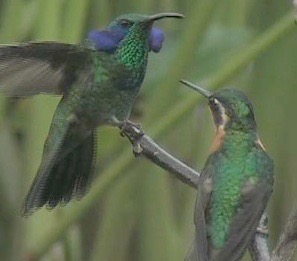
Stills taken from video are generally lower resolution than digital or analog stills taken with a still camera. There are a number of reasons for this but the major difference is that they are really different mediums. The photograph to the right is from a video sequence shot in the Saverge Valley in November - in the rain. The video is flawlessly beautiful. The still taken from a sequence shows motion artifacts especially in the wings and tail. Video is typically shot at 1/30th of a second - an image shot with a still camera at this speed under these lighting conditions would show this as more of a blur rather than the shadowing shown here which results because two video fields are depicted. Although this photograph hints at the motion and interaction between the two species (a Green Violetear and a female White-throated Mountain-Gem) only the video captures the full excitement of this little conflict. (Since this was originally written the Green Violetear has been split into two species, the Mexican Violetear which is found south to Nicaragua and the Lesser Violetear, found from the mountains of Costa Rica south into South America.)
MANGOS
...As I thought of yesterday’s walk, and the mangos for lunch, I was reminded of a time when Jon and I sat on a porch in the Guanacaste of Costa Rica discussing the price of mangos with one of the staff at Hacienda Los Innocentes. When I told him that I had to pay one US dollar for a mango where I lived in Oregon he was beyond disbelief. A US dollar was quite a sum of money and here in front him were mango trees, with the fruit going uneaten. Oh, the economics and logistics of transport....
VIDEO OF INDIVIDUAL SPECIES - LISTING FOR COSTA RICA